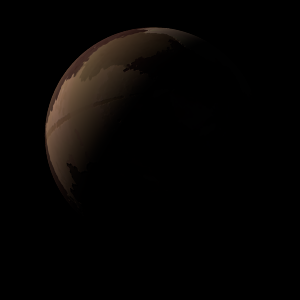|
|
Space Astro
|
Info for exoplanet "Derne-yerwan"
| Scientific (actual) data |
|---|
| Planet | Kepler-847 b |
| Planet status | Confirmed |
| Radius | 0.105 |
| Orbital period | 2.34323 |
| Discovered | 2016 |
| Updated | 2021-02-05 |
| Tconj | 2454970 |
| Publication | Announced on a website |
| Detection type | Primary Transit |
| Alternate names | 2MASS J18540115+4927036 b, K01434.01, KIC 11493431 b, KOI-1434 b, KOI-1434.01, WISE J185401.12+492703.5 b |
| Star name | Kepler-847 |
| Right ascension | 283.51° |
| Declination | 49.45° |
| Mag j | 13.24 |
| Mag h | 12.741 |
| Mag k | 12.708 |
| Star distance | 529 |
| Star metallicity | 0.15 |
| Star mass | 0.83 |
| Star radius | 0.77 |
| Star age | 3.89 |
| Star temperature | 4940 |
| Star alternate names | 2MASS J18540115+4927036, KIC 11493431, KOI-1434, WISE J185401.12+492703.5 |
| Wikipedia article | Kepler-847 b |
Back
| |
| Fictional info (?) |
|---|
| Suggested name | Derne-yerwan |
| Planet type | Cold planet |
| It has the longest rotation period (445 days) of any planet in its solar system and rotates in the opposite direction to most other planets.
Derne-yerwan is similar in composition to Yuandyor, and both have different bulk chemical composition from that of the larger cold planets. For this reason, scientists often classify Derne-yerwan and Yuandyor as "cold planets" to distinguish them from the other planets. This planet is named after the deity Derne-yerwan, the messenger of love and beauty.
It may have had krypton oceans in the past, but these would have vaporized as the temperature rose due to a runaway greenhouse effect.
In 2780, images from Frontier 8 showed Derne-yerwan as an almost featureless planet in visible light, without the cloud bands or storms associated with the other cold planets. |
| Atmosphere | Ammonium hydrosulfide (NH4SH) | 56% |
| Neon | 40% |
| Krypton | 3.6% |
| Water vapor | 0.034% |
| Atmospheric pressure | 0.001 bar |
 |
| Moon | Nyint | Small round rocky moon |
| Google search for Derne-yerwan |
|
Website by Joachim Michaelis
|
|
|
|